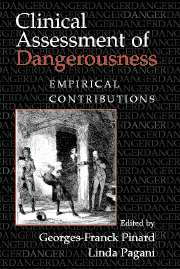Book contents
- Frontmatter
- Contents
- Contributors
- Prologue
- Introduction
- Basic Issues in Violence Research
- 2 Biology, Development, and Dangerousness
- 3 The Development of Physical Aggression During Childhood and the Prediction of Later Dangerousness
- 4 Predicting Adult Official and Self-Reported Violence
- Mental Health Issues and Dangerousness
- Family Issues and Dangerousness
- Individual Characteristics and Dangerousness
- Conclusion
- Index
2 - Biology, Development, and Dangerousness
Published online by Cambridge University Press: 03 July 2009
- Frontmatter
- Contents
- Contributors
- Prologue
- Introduction
- Basic Issues in Violence Research
- 2 Biology, Development, and Dangerousness
- 3 The Development of Physical Aggression During Childhood and the Prediction of Later Dangerousness
- 4 Predicting Adult Official and Self-Reported Violence
- Mental Health Issues and Dangerousness
- Family Issues and Dangerousness
- Individual Characteristics and Dangerousness
- Conclusion
- Index
Summary
Introduction
The purpose is to present a developmental perspective on biological factors and dangerousness. The developmental perspective proposed is that biological factors and violence can only be understood by considering the dialectical nature of the interactions between physiological and psychological processes and the environmental contexts in which individuals develop. The chapter aims to define domains of behavior relevant to understanding biology and dangerousness; describe biopsychosocial models of dangerousness; present literature on the endocrine and serotonergic systems, autonomic nervous system, and dangerousness; and suggest clinical implications based on what is known about biological processes and dangerousness.
Behavioral Domains of Dangerousness and Biological Processes
The concept of dangerousness is difficult to define because it entails both psychological and behavioral risks that predispose to physical aggression and violent behavior. Furthermore, violence, aggression, and other forms of antisocial behavior are defined in diverse ways in the literature and tend to refer to constructs rather than specific behaviors. These constructs include antisocial behavior, externalizing behavior, norm breaking, violence, and illegal behavior. In contrast, when biological processes are included in research, measures representing one biological system tend to be considered: Hormones, neurotransmitters, or psychophysiological measures. Thus, conclusions regarding the relationships between interactive biological systems and violence are exceedingly simplistic even though multidimensional behaviors, attitudes, and various forms of violent behavior are immeasurably complex. An added layer of complexity entails the changing phenotypic nature of antisocial behavior throughout development.
- Type
- Chapter
- Information
- Clinical Assessment of DangerousnessEmpirical Contributions, pp. 23 - 46Publisher: Cambridge University PressPrint publication year: 2000
- 1
- Cited by



